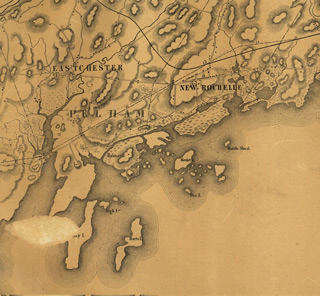| Farmers (1680 - 1850) |
|
From Colonial times to the mid-19th century, Davids Island was one of many small islands off the north shore of Long Island Sound used for farming and pasturing animals. Permanent Euroamerican occupation of Davids Island began in the early 1700s, or perhaps a little earlier. From then until around the mid-1800s, written accounts indicate that Davids Island supported a farmstead that included a dwelling, a barn and outbuildings, though the locations of these on the island is unknown.
For over a century and a half, the farm had a succession of owners and tenants. Davids Island was in the hands of New Rochelle’s early Huguenot (French Protestant) settlers from 1687 until 1732. The island was part of the lands Jean Bouteillier, one of the original promoters of the New Rochelle settlement, acquired from Thomas Pell some three decades after Pell obtained much of southern Westchester County from the Siwanoy Indians. Bouteillier subsequently sold to Jacob Leisler, Jr., and Guillaume LeConte, who in turn sold to Antoine Lispenard in 1708 and 1714. In 1732 Joseph Rodman, an English Quaker from Flushing, New York, purchased Lispenard’s land. In this and other early transactions, Davids Island was transferred from one owner to another as part of a larger transaction involving part or all of Davenport Neck on the mainland.
Over this period, Davids Island was known by a succession of names, reflecting its changing ownership, or, occasionally, the prominence of a tenant. Before 1856, when Thaddeus Davids, Sr., purchased the island, it was variously known as Bouteillier's Island, Rodman’s Island, Myer’s or Wyer’s Island, Hewitt’s Island, Davenport’s Island and Morse’s Island. |




 Farmers (1680 - 1850)
Farmers (1680 - 1850)